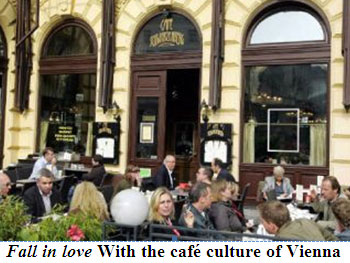
 For lovingly preserved palaces, museums, traditional architectural styles and classical music
For lovingly preserved palaces, museums, traditional architectural styles and classical music
Home to Strauss, Brahms, Beethoven, Schubert; every corner a photo opportunity; grandiose architecture dating from centuries ago to modern; a plethora of museums; and over 800 coffee-houses: Vienna is certainly the cultural capital of Europe! In 1857 , the city walls and the bastions were destroyed, and after that a splendid boulevard encircling the city, called the ‘Ring’ was constructed, which has government buildings, elegant cafes and parks. We have just two days to discover this city which has centuries of history to offer.
We board the tram that goes around the Ring, and gives us a quick glimpse of the architectural styles, pedestrian shopping streets and the typical Viennese café. Stephansdom, or the cathedral, is the famous landmark of Vienna. Its crowning glory is the steep roof laid out in dazzling patterns. It dates back to the 12th Century, and was reconstructed in the Gothic style in the 15th Century. The main building is encased in scaffolding for renovation, but as we enter the cathedral, and sit in a pew, we feel a connection to all those workers whose labour had gone into the exquisite interiors. There is a huge pipe organ and the famous pulpit with a stone dog stopping the toads and lizards (the symbols of evil). The richly decorated altar and the intricate statues take our breath away.
We walk past the imperial palace or the Hofburg where horses and carriages are vying with each other for tourists’ trade. We enter Burggarten, a garden which has a huge statue of Mozart. We wait for our turn to be photographed next to the musical maestro, and then rest our feet next to the huge crowd of sun-worshippers on the lawns here. We head towards the Museum Quartier, a huge complex of museums where you buy a combination ticket for about 25 euros, and see a marvellous array of museums!
We have time only for one, and it has to be the Leopold museum which houses modern and contemporary art. The scene outside the museums is amazing — cafes and new-age seats to sprawl on between museum-hopping. It is soon time for a Viennese coffee-break, and we choose Zanoni and Zanoni near Stephansdom, a vibrant place bursting with people, where we get to sample the rich ‘Sacher torte’, a delicious pastry typical of this city. With renewed vigour we take the U Bahn (the efficient underground railway) to the Prater, which is an old fashioned amusement park where you pay for each ride instead of one combined entry ticket. The Prater has a huge Ferris wheel, featured in several movies, and has cabins instead of seats. It is known to have survived natural catastrophes and the acts of war. It is the last day in Vienna, and we decide to devote it to the famous Schonbrunn Palace (a mini Versailles). This was originally a hunting lodge, and later the summer home of the Austrian royalty. The building is an incredible bright yellow, and has the Staterooms and the private apartments of the imperial couple, Franz Joseph and Elisabeth (also known as Sisi).There are nearly 1,400 rooms here and include a parlour where six-year-old Mozart played for the Empress!
We take a stroll in the formal gardens with a maze, a Japanese garden, and a gloriette on the hill with a spectacular view of the palace. We then visit the Tiergarten or the Vienna zoo on the ground, supposed to be the oldest zoo in Europe, dating back to 1760! It has an astounding array of animals from anteaters to giraffes and pandas, and all kinds of birds including the penguin. There are numerous cafes dotting the landscape, aiding the Austrian preoccupation with desserts and coffee.
You don’t have to be a history buff to appreciate the grandeur of this city. I fell in love with its walkability, café culture, green spaces and the impeccably dressed, friendly people!
Published in The Hindu Metro Plus, 2009

